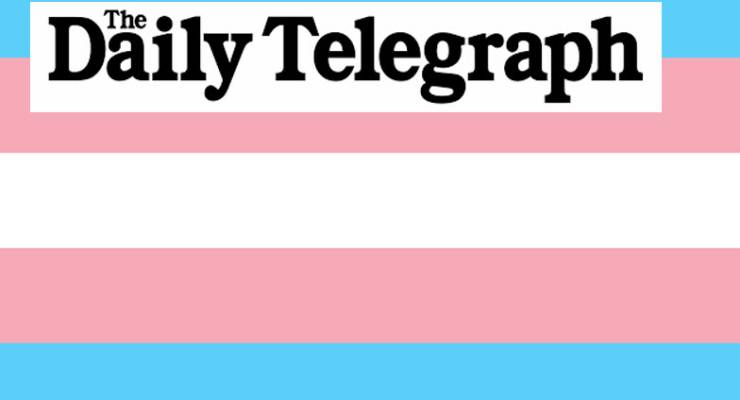
Evie Amati is perhaps, for now, one of Australia’s most famous transgender people. Not because of her identity, but for her recent conviction of attempted murder over her unprovoked assault of three strangers with an axe, at a 7-Eleven in Sydney.
Despite the irrelevance of Amati’s gender identity to the attack, four days after it occurred, The Daily Telegraph columnist Tim Blair wrote this blog post on the Tele’s website (edited):
Allegedly Axing Evie
Having being [sic] chopped herself, Sydney trannie Evie Amati allegedly sought to share the experience.
The previous he apparently doesn’t like people who buy pies or milk.
Evie Amati, who police allege carried out the terrifying axe attack… is a transgender union employee who used to be known as Karl.
The 24 year old… transitioned to a female four years ago.
Ms Amati, currently in custody after being refused bail, is charged with intentionally causing grievous bodily harm and being way too Adelaide for Sydney.
A transgender person (not Amati) complained to News and the Press Council that Blair had vilified transgender people. That went nowhere, so the complainant took their case to the NSW Civil & Administrative Tribunal (NCAT) under s.38S of the Anti-Discrimination Act, which makes it unlawful, by a public act, to “incite hatred towards, serious contempt for, or severe ridicule of a person or a group” on the ground that they are transgender. Identical anti-vilification laws apply to race, sexuality and HIV/AIDS status.
NCAT had no difficulty in finding that Blair’s “attempt at humour was in poor taste and completely devoid of empathy or sensitivity”, and contributed “to the perpetration and perpetuation of demeaning negative stereotypes and a lack of acceptance of transgender people within the community”. However, although it came “close to the line” of inciting severe ridicule, it didn’t quite cross it. The case failed.
In the process, the tribunal was forced to dive headfirst into a semantic swamp. The courts have ruled that the test for vilification is objective: you have to identify the particular audience at which the conduct was aimed (in this case, as the Telegraph described its own readers, “more Footy Show than Four Corners“). Then you find the “ordinary” member of that audience and decide whether the conduct was capable of inciting hatred, serious contempt or severe ridicule in that person, towards the targeted person or group.
Ultimately, the question in this case was whether — accepting that Blair’s words were likely to incite contempt and ridicule — the contempt was “serious” or the ridicule was “severe”. There was also the unedifying task of determining whether “trannie” is or is not a pejorative term. As the tribunal noted, while the test is supposedly objective, it is at the same time “inevitably impressionistic”. Which is to say that it cannot possibly be objectively assessed.
Stepping back from the disappointment no doubt felt by the applicant and the transgender community at this non-vindication from the legal system of the vilification which they constantly receive, we should ask what exactly we’re achieving here.
Blair’s post is a useful example of anti-social behaviour. He jumped onto an irrelevant aspect of a topical event — Amati’s transgender identity, which was not the cause of her crime — and made fun of it. He amused himself and probably a good proportion of his readers.
There are three perspectives to examine: those of Blair, his audience, and the targeted minority. Because of the courts’ interpretation of section 38S, attention is focused on the audience only. The section itself says that it is “unlawful for a person, by a public act, to incite hatred [etc]”. That could have been read as attacking the act itself and its motivation, i.e. what the person did or said, not the effect it might have had. But that’s not how the courts have seen it.
Either way, the targeted group is ignored. This is different from s.18C of the Commonwealth Racial Discrimination Act, which measures illegality by reference to the effect that the racist conduct has on its targets — whether it offends, insults, humiliates or intimidates them. Where behaviour singles out, objectifies and vituperates a minority on their irrelevant differences from the mythical “norm”, it makes obvious sense to outlaw it when it causes direct harm and has no rational, socially utilitarian excuse (which is protected, in appropriately wide terms, by s.18D).
Equally appropriately, acts intended (including by reckless disregard) to incite actual violence or intimidation of people or groups by reference to their minority status are crimes. These look to the act itself and the subjective motivation of the actor.
But what exactly is the social relevance of the supposedly objectively measured effect that a provocateur’s words may have on his own self-selected audience? If a neo-Nazi stands up at a neo-Nazi meeting and calls for the extermination of a racial minority, surely the question for society is whether we want to allow him to make that call? That should be checked against his words and his intent, not determined by reference to just how racist and vile the people in his audience already were before he got up? That is not, however, the way cases like Blair’s are currently assessed. The result is an exercise in pointless semantics.
Personally, I don’t think that an expression of free speech such as Blair’s puerile blog post should be unlawful. It should be called out for what it is, and his employer should have sufficient social responsibility to cease publishing his recklessly hurtful attempts at wit — because he did, and does, harm.








I’m transgender. I also work in media, in an environment which would be described, at best, as transphobic. I don’t disclose my transgender status, and am compelled to laugh along at jokes that are sometimes at my own expense. Just so I can avoid being homeless or forced into sex work merely to survive.
It’s absolutely remarkable to me how the standard for prejudice and vilification is different for transgender Australians than any other class of people.
Consider if this article had targeted a gay Australian instead of a trans Australian. If Blair had referred to the attacker as a “F*ggot” (a term which is also marked offensive in both major dictionaries) and incorporated repeated gratuitous and demeaning references to homosexual intercourse, most people would comprehend why this meets the high bar for vilification.
Equally, if the article had targeted an indigenous Australian, referring to them as “n*gger” and including repeated demeaning references to race, then most people would comprehend the harm (The word “n*gger” is considered offensive by both major dictionaries, as is the word “tr*nny”).
I find it surprising that people want to enter into semantic arguments about whether the word “tranny” is offensive. I’m transgender. I’ve been spat on whilst called that word. I’ve received death threats that used the word “tranny”. I’ve been assaulted whilst called that word. I’ve been abused using that word – merely for going about my day. If that’s not compelling evidence that the word is a slur, then I don’t know what is.
The harm these articles have on transgender people is not hypothetical. I am aware of at least one transgender adolescent reader of the article who committed suicide in Sydney in the time between when this article was published and the Tribunal’s findings. That’s not to say that the article was the sole cause, but these kind of uncurbed and unrelenting attacks DO certainly sustain and even legitimate the gross social prejudice transgender Australians experience. Why do YOU think it is that 46% of transgender women have been attacked with a weapon such as a knife, rock, or bottle? Why do you think it is that 22% of transgender children have been kicked out of the family home and made homeless before the age of 14? Why do you think it is that 94% of transgender children report indicators of social rejection, isolation, intolerance and bullying, and 48% attempt suicide.
If the Press Council is more than 18 months behind in processing adjudications and is too busy arguing over politics to address serious ethical problems in media, how do you think we solve these issues? What good is a vilification law if it doesn’t address issues of social division and prejudice?
Michael, I keep wanting to thank you for your periodic contributions to Crikey.
I think a legal exploration of how legislation is interpreted and ajudged is a critical part of the policy picture; it’s one that I have very little knowledge about, and I greatly appreciate the way you explore how and why before voicing your own view about so what.
From an informatics perspective I believe it’s perfectly testable whether an article is capable of inciting hatred and contempt. We already have reliable clinical tests for antipathy and disrespect. It’s not hard to run a controlled test to see whether an article primes readers for it, and from there it’s a short step to demonstrate that the groups chosen are typical of the expected demographic, and that editors either anticipated or should reasonably have anticipated that this might occur, regardless of whether they undertook a clinical trial or even a focus group themselves.
I agree that in the end, the test has to revolve around detecting the abuse of influence to produce avoidable harm. I rather like the definition offered by Dr Phil Zimbardo, author of the notorious Stanford Prison Experiment, that evil is a deliberate act to produce needless hurt, harm or destruction of another thinking being.
In an informed environment, such articles aren’t simply negligent; they’re deliberately malignant and you don’t have to work too hard to show that this is so.
It disturbs me that we reside in a largely postmodern and relativistic environment where people still insist authoritatively that there’s no authoritative knowledge about communications and moral impacts.
Nice work on a difficult topic — thanks.
thanks for explaining the law in plain english, feeling better equipped to deal with the ambiguities now, I think
Fancy calling someone a Union employee….shocking!
During the 18C teacup typhoon it was alleged by too many that it the intent of words uttered/written doesn’t matter but how they are perceived by the aggrieved.
That way lies madness.
AR wrote: During the 18C teacup typhoon it was alleged by too many that it the intent of words uttered/written doesn’t matter but how they are perceived by the aggrieved.
That way lies madness.
A false dichotomy, I think, AR. When it comes to professional publication the underlying ethical principle ought to be that an organ is visible, active and committed to respecting the agency and dignity of the citizens it purports to serve.
Since its expertise ought to be in exploring topics intelligently and sensitively for its target readers, it needs to know that demographic and demonstrate it has done diligence for it, and that it is not advising or encouraging acts likely to be harmful. I thought Michael’s take on that was illuminating, since it represented legislation and a judiciary smarter than I had known them to be (i.e. not perfect, but not nearly as imperfect as expected.) Michael’s taken on unlawful vs unprofessional mirrors my own.
As I see it, a key problem with getting legislation right on this is that people keep recasting the issue as rights owed, rather than responsibilities owing; and concommitantly, legal penalties vs ethical sanctions.
The supposed right to be able to say anything with impunity for any harm it may do is no more sensible than the supposed right to stroll the Earth and never be offended by what one hears. I think this is what leads to the good intentions/victim veto racket — neither of which is any more sensible than the assumptions framing it.